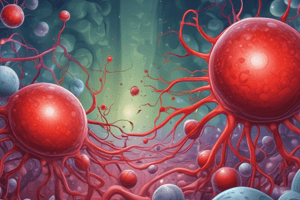Podcast
Questions and Answers
What is the primary characteristic of Idiopathic Thrombocytopenic Purpura (ITP)?
What is the primary characteristic of Idiopathic Thrombocytopenic Purpura (ITP)?
- Vascular disorder
- Increased production of circulating platelets
- Coagulation disorder
- Autoimmune disease with antiplatelet antibodies and shortened platelet life span (correct)
Which of the following is a common feature of chronic ITP?
Which of the following is a common feature of chronic ITP?
- No mucose membranes bleeding
- Women predominance with a female-to-male ratio of 3:1 (correct)
- Spontaneous recovery within 4-6 weeks
- Organomegaly
What is the most common cause of isolated thrombocytopenia?
What is the most common cause of isolated thrombocytopenia?
- Idiopathic Thrombocytopenic Purpura (ITP) (correct)
- Malignancies
- Drug-induced thrombocytopenia
- Chronic autoimmune disorders
Flashcards are hidden until you start studying
Study Notes
Bleeding Diathesis
- Caused by inherited or acquired defects of vessel wall, platelets number and/or function, and coagulation system
- Characterized by spontaneous bleeding and extensive bleeding after minimal trauma
Vascular Disorders
Congenital
- Ehlers-Danlos syndrome: increased skin elasticity, capillary fragility, and hypermobility of joints
- Hereditary hemorragic telangiectasia: thin and dilated capillary walls, autosomal dominant, presented in adults
- Giant hemangioma: angiomatous malformation
Acquired
- Scurvy (vitamin C deficiency)
- Senile purpura
- Sepsis (meningococcal)
- Steroid-induced
- Malignancy
- Immune (vasculitis)
Clinical Picture
- Purpura (raised)
- Echymosis
- Mucosal bleeding
- Internal bleeding
- Rare muscle bleeding
- Never hemarthrosis
- Positive Hess test and prolonged bleeding time
- Normal CBC, PT, APTT, and clotting time
Henoch-Schonlein Purpura
- Usually seen in children
- Often follows an acute upper respiratory tract infection
- Immunoglobulin A (IgA) - mediated vasculitis
- Characteristic purpuric rash accompanied by localized edema and itching
- Painful joint swelling, hematuria, and abdominal pain may occur
- Usually self-limiting, but occasional patients develop renal failure
- Systemic affection indicates steroid therapy
- Positive Hess test
- Normal platelets, PT, and APTT
- Elevated IgA
- Skin biopsy with IgA deposit
Platelet Disorders
- Disorders of platelet number: thrombocytopenia and thrombocytosis
- Disorders of platelet function
Classification of Platelet Disorders
- Quantitative disorders:
- Abnormal distribution
- Dilution effect
- Decreased production
- Increased destruction
- Qualitative disorders:
- Inherited disorders (rare)
- Acquired disorders
- Medications
- Chronic renal failure
- Cardiopulmonary bypass
Decreased Marrow Production of Megakaryocytes
- Congenital disorders:
- Thrombocytopenia with absent radii (TAR)
- Fanconi's anemia (pancytopenia)
- Acquired disorders:
- Marrow infiltration with malignant cells
- Marrow fibrosis
- Aplastic and hypoplastic anemias (idiopathic, drugs, toxins)
- Deficiency states (vitamin B12, folate)
- Paroxysmal nocturnal hemoglobinuria
Splenic Sequestration of Circulating Platelets
- Splenic enlargement due to tumor infiltration
- Splenic enlargement due to portal hypertension
Increased Consumption
- DIC
- Hemolytic-uremic syndrome
- Thrombotic thrombocytopenic purpura
Increased Destruction of Circulating Platelets
- Primary:
- Idiopathic thrombocytopenic purpura (ITP) - acute and chronic
- Secondary:
- Drug-induced thrombocytopenia
- Chronic autoimmune disorders (SLE)
- Infection (HIV, EBV)
- Malignancies, lymphoma
Idiopathic Thrombocytopenic Purpura (ITP)
- Most common cause of isolated thrombocytopenia
- Autoimmune disease with antiplatelet antibodies and shortened platelet lifespan
- Forms of ITP:
- Acute ITP:
- Most common in children
- Preceded by viral infection
- Sex equal
- Spontaneous recovery within 4-6 weeks in 90% of patients
- Chronic ITP:
- Typically seen in 20-40-year-olds
- Women predominant (F:M=3:1)
- Chronic course
- Secondary to other autoimmune diseases
- Acute ITP:
Clinical Features of ITP
- Petechiae
- Ecchymoses
- Mucosal membrane bleeding
- Menorrhagia
- Rare internal and intracranial bleeding
- No organomegaly
Diagnosis of ITP
- Platelet count
Studying That Suits You
Use AI to generate personalized quizzes and flashcards to suit your learning preferences.




